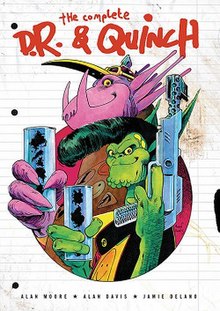D.R. and Quinch
| D.R. & Quinch | |||
|---|---|---|---|

Cover to The Complete D.R. & Quinch, 2006 featuring the title characters. Art by Alan Davis.
|
|||
| Created by |
Alan Moore Alan Davis |
||
| Publication information | |||
| Publisher | Originally IPC Media (Fleetway) until 1999, thereafter Rebellion Developments | ||
| Schedule | Weekly | ||
|
|||
| Genre | |||
| Publication date | May 1983 – August 1987 | ||
| Creative team | |||
| Writer(s) |
Alan Moore Jamie Delano |
||
| Artist(s) | Alan Davis | ||
| Letterer(s) | Steve Potter | ||
| Creator(s) |
Alan Moore Alan Davis |
||
| Editor(s) | Tharg (Steve MacManus) | ||
D.R. & Quinch is a comic strip about two delinquent alien drop-outs. It was created by Alan Moore and Alan Davis for the British weekly comics anthology 2000 AD. It first appeared in 1983.
D.R. and Quinch began in 2000 AD as a one-off Time Twister titled “D.R. and Quinch Have Fun On Earth”. The characters were initially meant to only appear once but they proved so popular that they were given their own semi-regular series.
The strip was the tale of how two alien teenage students Waldo "D.R." (for "Diminished Responsibility") Dobbs, a scheming criminal mastermind, and Ernest Errol Quinch, his muscular purple skinned companion in crime, have influenced Earth's history in various anarchic ways.
D.R. and Quinch were inspired by the National Lampoon characters O.C. and Stiggs. The film Animal House has also been cited as an influence. Alan Davis took visual inspiration from the cartoon style of Leo Baxindale’s Grimly Feendish. Alan Moore has described D.R. & Quinch as belonging to the tradition of British teenage delinquency comics, comparable to Dennis the Menace except with “a thermonuclear capacity”.
D.R. & Quinch's anarchic humour was popular with its original audience but Alan Moore has expressed discomfort with how it exploits violence for comic effect, claiming that it has no “lasting or redeeming social value”. The series has had a strong reputation since it was first published. It stands out as something so obviously different when compared to the rest of Moore’s body of work that it is worthy of attention. It has been called the "absurd, cartoony, delightfully vicious other side of Halo Jones". Writing for Time Douglas Wolk has described it as, for the majority of its run, "one of the funniest comics ever" and Neil Gaiman has credited it with being one of the greatest 2000 AD stories.
...
Wikipedia
